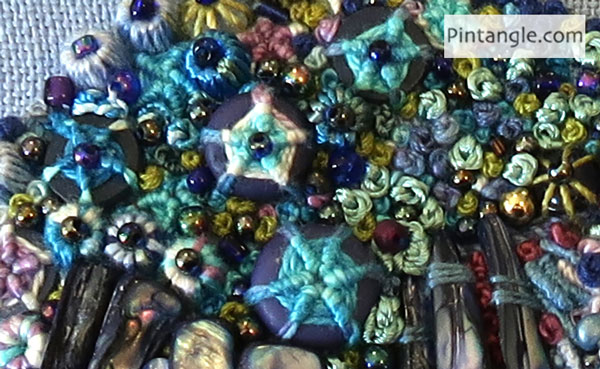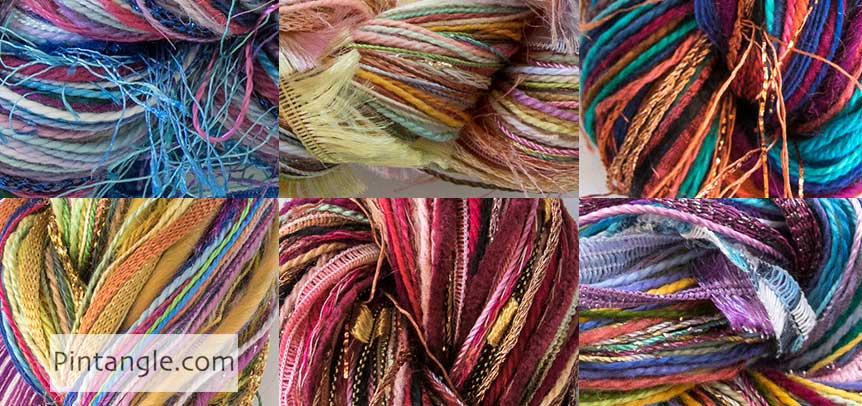 For me wobbly stitches rule! I have noticed that some beginners to embroidery apologise for their wobbly stitches. To be honest I don’t think it is necessary. I will tell you why. This is the 21st century. We are surrounded by machine made things. Some of these things are ugly, some are beautiful, some are practical, some have sentimental value, some are status symbols and some I look at and wonder why they exist. All these things have different roles in our life. All serve different purposes but the thing they have in common is that they are machine made. They are smooth or straight or, well… machined. As humans the things we make with our hands are not perfect. We may strive to make things as well as possible but there is always a ‘flaw’. I don’t see it as a flaw because if it is, it is the flaw of being human so wobbly stitches are OK.
For me wobbly stitches rule! I have noticed that some beginners to embroidery apologise for their wobbly stitches. To be honest I don’t think it is necessary. I will tell you why. This is the 21st century. We are surrounded by machine made things. Some of these things are ugly, some are beautiful, some are practical, some have sentimental value, some are status symbols and some I look at and wonder why they exist. All these things have different roles in our life. All serve different purposes but the thing they have in common is that they are machine made. They are smooth or straight or, well… machined. As humans the things we make with our hands are not perfect. We may strive to make things as well as possible but there is always a ‘flaw’. I don’t see it as a flaw because if it is, it is the flaw of being human so wobbly stitches are OK.
In an era where we are time poor to make a thing is more about the philosophy of the maker than anything else. Even if you just say to yourself “there is nothing ‘deep’ about what I make I just enjoy the making”. Or you might say “I just enjoy the process!” That is a choice. You have decided to spend time making something rather than gazing at a screen, or doing something else. You have given yourself permission to learn a skill and in my opinion develop your creativity. No matter if you stitch simply to relax or you enjoy the process or you embrace the whole slow stitching/mindful movement, no matter how you frame it, the thing you make is human. It reflects your human creativity. That is a good thing in the world. So in my book… wobbly stitches are OK!

This is my latest little exploration. One of the aspects of hand embroidery I love is that you can create rich textured surfaces with stitches. I have been working on series of disks that are a sort of extreme surface embroidery. They explore the idea that hand embroidery can create a surface that machines can not. These disks of texture will eventually be arranged together in a wall piece. This disk is one of them fresh off the hoop. It has a 10 centimetre (4 inch) diameter and is made up beads, wrapped beads, whipped wheel stitch, French knots and Bullion Knots. Threads used are Cotton Perle #5 and #8 some of which is hand dyed by me. There are quite a few hand dyed silk threads, some rayon thread and a thread that is a mix of wool and silk. All of these I have included in my thread twisties mix.
I thought you may enjoy seeing it.
You can have Pintangle delivered to your inbox by using the ‘Subscribe’ feature in the sidebar. Just enter your email address, and when you get the confirmation email make sure you click ‘yes’ and you are all set! If you are on a mobile, or tablet you will need to scroll to the bottom to find the ‘Subscribe to Pintangle’ field.

Thread Twisties
Experimenting with different threads can be expensive, as you would normally have to buy a whole skein of each type of thread. My thread twisties are a combination of different threads to use in creative hand embroidery. These enable you to try out stitching with something other than stranded cotton. For the price of just a few skeins, you can experiment with a bundle of threads of luscious colours and many different textures.
These are creative embroiders threads. With them, I hope to encourage you to experiment. Each Twistie is a thread bundle containing silk, cotton, rayon and wool. Threads range from extra fine (the same thickness as 1 strand of embroidery floss) to chunky couchable textured yarns. All threads have a soft and manageable drape so that twisting them around a needle makes experimental hand embroidery an interesting journey rather than a battle. Many are hand dyed by me. All are threads I use. You may find a similar thread twist but no two are identical.
You will find my thread twisties in the Pintangle shop here.



Hand work has a beauty beyond anything machine made. Furthermore it is much more enjoyable to stitch by hand.
You have inspired me to make several ‘pile ’em on’ embroideries where the stitches are crammed against or over each other. Your latest circle is yet another inspiration.
I am interested in subscribing. Your work is beautiful
!!
Chrys I am pleased you want to subscribe -there is a subscription button in the side bar or scroll to the bottom if you are on a mobile phone or tablet
Gorgeous work, love it!
lovely work! well said!
Chitra
I love your philosophy
Your work reflects your thoughts, and you are a treasure of n example for so many of us. Thank you for such a kind and thoughtful post.
I love this kind of embroidery. Love the colors, textures and freeform design. My eye sees something new each time.
Bravo Sharon…wise words indeed. I will share on FB and hope that every one of my friends reads it!
Thanks for all you do for us stitchers, Sharon. Your rich surfaces are inspirational and your Wobbly Manifesto on point!
Loved the disk . I also like your take on wobbly stitches and why they represent each person’s unique approach to their work.
I enjoyed reading about your philosophical approach to wobbly stitches. There is something captivating in seeing a piece of hand stitched embroidery and appreciating how the embroiderer was doing her best to create something that brought her joy, wobbly stitches or not. It’s only by making those wobbly stitches and practicing that we become more skilled.
The texture of you disc is fascinating and I love the little splash of yellow that brings it all to life. It’s beautiful!
Your explorations in embroidery amaze and inspire!
Bravo and well said, Sharon! I totally agree with your opinions here. ‘Hand created’ has a heart and a soul, placed there by its creator’s heart and soul!
I love your discs…very inspiring. Thank you for sharing.
Sincerely,
Suzanne
I so enjoyed looking at this piece you have created & drifted away into dreams of what I could do to emulate your work. Thank you for that & also for your words of wisdom. It is so true that hand stitching should be enjoyable, if it isn’t it becomes a chore. I hope you don’t mind but I am going to print off today’s topic & show it to some of the ladies in a stitching group I belong to as they worry constantly about wobbly stitches etc & are losing the enjoyment of the work.
Thank you so much
Thank you for your reflection on being human. It made me want to relax and accept my humanness.
LOVE IT !
These are fabulous – I love the density of them, it makes them so complex, even though each stitch might be simple
Love your stitched piece Sharon – the colours, textures..ooh la la!
Beautiful texture and rich colours Sharon, I would much prefer doing 50 loopy french stitches than 200 teeny perfect ones, much quicker and looks far better.
Amen! That’s exactly why I love hand stitching..it’s not machine made, and I hope it looks that way.
Absolutely gorgeous stitching!
Sharon, an excellent reminder! I’m going to share this post with a dear friend who spends too much time ripping out her stitches because they are not good enough. Your disk is stunning! Thanks for sharing….
What a wonderful piece of advice. We get so wrapped up in “perfection” that we lose the joy in just stitching! Thank you.
I love encrusted stitching. I too appreciate wobbly stitches. While I always do the best I can on any piece, I’m in my 70’s, and I’m pretty wobbly these days myself.
Thank you Sharon, for reassuring us – your students! Human hand versus machine – hands are the winner! Hurray for needles and threads – fabrics and also a little paper ……
Thank you very much for writing this post. Everything you say is absolutely true. As a wobbly embroiderer myself, I am sometimes daunted by the amazing stitching I see on the internet but I enjoy the process and will, I expect, slowly improve but never be anywhere close to perfect. We are not machines and I completely agree that human creativity is a very good thing and we should celebrate it. Thank you also for all the stitching information and inspiration. I love your textured disks and will look forward to seeing more
I appreciate your perspective on imperfection in handmade projects . The imperfect, asymmetrical row of stitches is often more interesting than a strictly controlled line. There is beauty in randomness, and sometimes a mistake (happy accident) reveals the potential of the materials one is using.
Beautifully said! Thank you!
I totally agree with you Sharon, wobbly stitches make us human, no computers. Love your new work!
Well said..I love wobbly stitches being a l8felong member of the wobbly club
Sharon thank you so much for this! Your words really strike a chord and it is so encouraging to read them. I love your disc too – looking forward to seeing more.
Yes what you say resonates with me, Sharon. I am also working on disks, they are small about 3cm in diameter. I am using stranded cottons with a variety of stitches – a lot of French knots bullions, spider web wheels, straight stitches, anything I can imagine. They will be cut out and made into medallions to sew sew onto a fine linen scarf. The basic design comes from Ko Maxwell at the ‘Elephant Patch’ Ballarat Victoria. I may in the future make larger circles as you are doing.
Morning Sharon, when starting off on this circular exercise do you start in the centre and work outwards, work a basic line at random around the circle edge or do an open stitch as a background, then fill it in.
Always wondered about your method especially with the encrusting embroideries.
Thank you for always being able to help with silly questions.
I love your philosophy on hand work and I like the embroidered disc, can’t wait to see the end piece.